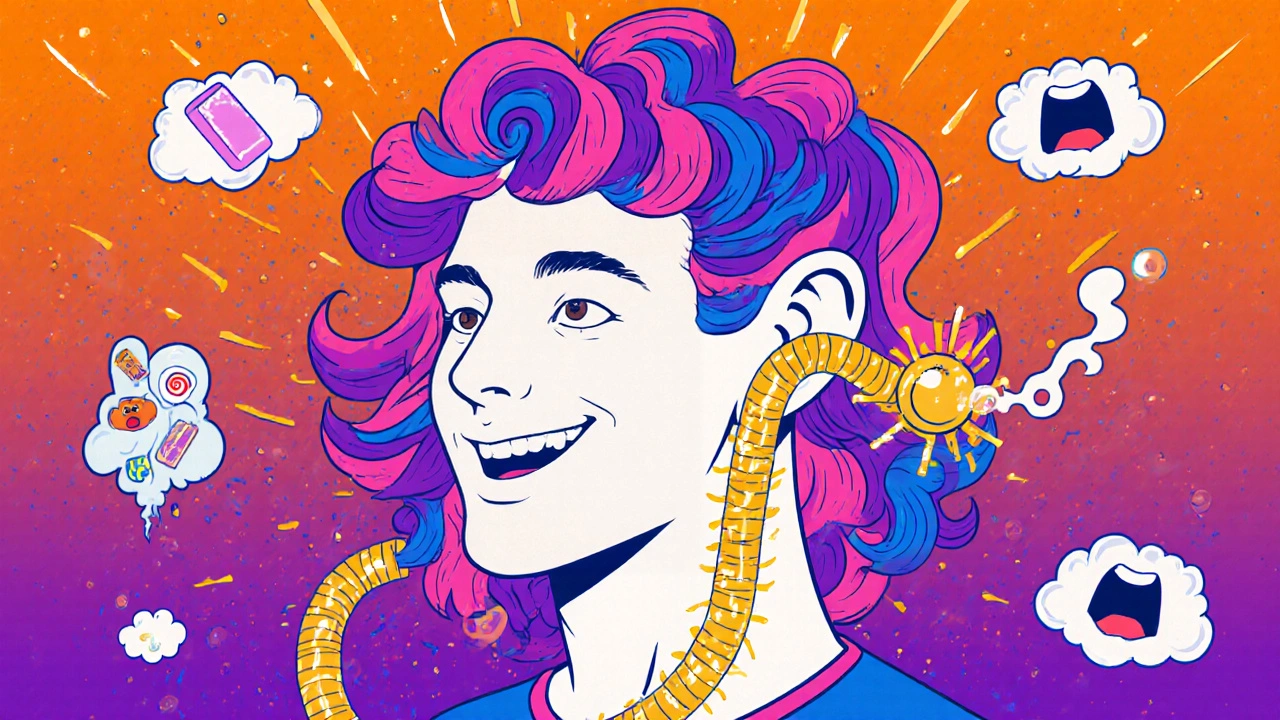Ever feel like your ears are stuffed with cotton, especially after a cold or during a flight? You’re not alone. Millions of people deal with Eustachian tube dysfunction - a condition where the tiny tube connecting your middle ear to your throat gets blocked, causing pressure, muffled hearing, and that weird popping sensation. It’s not an infection. It’s not swimmer’s ear. It’s something much more common - and often misunderstood.
What Exactly Is Eustachian Tube Dysfunction?
Your Eustachian tube is about the size of a pencil lead. It opens briefly when you swallow, yawn, or chew to let air in and out of your middle ear. This keeps pressure balanced on both sides of your eardrum. When it won’t open - because of swelling from a cold, allergies, or sinus congestion - air gets trapped inside the middle ear. The lining slowly absorbs that air, creating negative pressure. That’s when your eardrum gets pulled inward. The result? Fullness, muffled sounds, and sometimes a dull ache. It’s not rare. Around 87% of people with this issue report constant ear pressure. Nearly 92% say their hearing sounds distant or underwater. And 78% hear popping or clicking when they swallow. These aren’t just minor annoyances. Left unchecked, the pressure can cause fluid buildup behind the eardrum, leading to hearing loss of 20 to 50 decibels - enough to make conversations fuzzy.What Triggers Eustachian Tube Dysfunction?
Most cases (68%) follow an upper respiratory infection - think colds, flu, or even lingering post-nasal drip. Allergies are the second biggest culprit (22%), especially during spring and fall. Sinus infections make up the rest (10%). Some people are more prone to it. Kids under 7 have narrower, more horizontal tubes, so they’re more likely to get blocked. Adults between 30 and 50 often struggle with it too, especially if they have chronic allergies or frequent sinus issues. Frequent flyers and people who drive through mountainous areas report flare-ups during altitude changes - 95% of sufferers notice symptoms getting worse during takeoff or landing.How Is It Different From an Ear Infection?
A lot of people confuse ETD with an ear infection. But there’s a key difference. Acute otitis media - a true middle ear infection - usually causes constant, sharp pain, fever, and sometimes drainage. ETD? The pain is usually dull, intermittent, and tied to pressure changes. You might feel fine one minute, then suddenly like your ear is full of air. Swimmer’s ear (otitis externa) hurts when you tug on your earlobe. ETD doesn’t. And barotrauma - ear pain from rapid pressure changes - is sudden and happens during the event (like diving or flying). ETD can stick around for weeks. The big red flag? Constant, severe pain. If your ear hurts all the time, even when you’re not swallowing or yawning, it’s probably not ETD. That could mean a real infection - or, very rarely, a growth in the back of the nose. Don’t ignore persistent pain.What You Can Do at Home
The good news? About 70% of cases clear up on their own within two weeks. You don’t always need meds or procedures. Here’s what works:- Swallowing - Do it often. Every 15 to 20 minutes during flare-ups. Sip water, suck on hard candy, or chew gum. The motion opens the tube.
- Yawning - Force a big yawn. Open your mouth wide and stretch your jaw. About 78% of people get relief this way.
- Chewing gum - Keep it going for 10 to 15 minutes every two hours. The repetitive motion helps.
- The Valsalva maneuver - Pinch your nose shut, close your mouth, and gently blow. Don’t blow hard. Just enough to feel your ears pop. About 65% of people find this helpful - but 45% do it wrong the first time. Too much force can hurt.
- Steam - Breathe in steam from a hot shower or bowl of hot water. It reduces swelling in the nasal passages and can help the tube open.

When to See a Doctor
If symptoms last more than two weeks - or if you notice hearing loss, dizziness, or fluid draining from the ear - it’s time to get checked. Also, if you’ve tried everything and still feel pressure after a month, you’re not just being impatient. You might have chronic ETD. Your doctor will look in your ear with an otoscope. But here’s the catch: in mild cases, your eardrum might look perfectly normal. That’s why diagnosis can be tricky. They’ll ask about your symptoms, recent illnesses, and whether pressure changes trigger the problem. If needed, they might do a hearing test or a tympanogram - a quick, painless test that measures how well your eardrum moves.Medical Treatments
If home care doesn’t cut it, your doctor might suggest:- Nasal decongestant sprays - Like oxymetazoline (Afrin). These shrink swollen tissue fast. But use them for no more than three days. Longer than that, and they cause rebound congestion - making your symptoms worse.
- Steroid nasal sprays - Fluticasone (Flonase) or mometasone. These reduce inflammation over time. You’ll need to use them daily for two to four weeks. They’re safe for longer use and work well for allergy-related ETD.
- Antihistamines - Only if allergies are the main cause. They’re not helpful for cold-related ETD and can dry out your nasal passages, making things worse.
- Antibiotics - Not recommended unless there’s a confirmed infection. The American Academy of Otolaryngology stopped recommending them for routine ETD in 2022.
Surgical Options for Chronic Cases
If nothing else works after three months, surgery might be an option. Two common procedures:- Balloon dilation of the Eustachian tube (BDET) - A tiny balloon is inserted through the nose and inflated inside the Eustachian tube. It gently widens the passageway. The whole thing takes about 20 minutes, done in the office under local anesthesia. Success rates? Around 67% after a year. Many patients report relief for six months to a year before symptoms return.
- Myringotomy - A small cut is made in the eardrum to drain fluid. A tiny tube might be placed to keep the ear ventilated. This is more common in kids with recurrent fluid buildup.

What Doesn’t Work
Don’t waste time or money on:- Ear candling - It’s dangerous and doesn’t help ETD.
- Over-the-counter ear drops - These only treat outer ear infections, not middle ear pressure.
- Blowing your nose too hard - This can force mucus into the middle ear and make things worse.
- Waiting too long - If you’ve had symptoms for over a month, don’t assume it’ll fix itself. Chronic ETD can lead to permanent hearing changes or recurrent infections.
Real Stories, Real Relief
One Reddit user, u/FrequentFlyerMD, says: “The Valsalva maneuver works like magic for me during flights. I do it before takeoff and landing - no more ear pain.” Another, u/ETDWarrior, tried balloon dilation: “Gave me six months of relief. Then the pressure came back. But at least I know there’s a next step.” And then there’s the frustration: “After my third flight this month, the pressure hasn’t equalized for 10 days. Decongestants aren’t helping.” That’s when people start looking for stronger solutions.What to Expect Long-Term
ETD isn’t going away. With cold and flu season peaking between October and March, about 65% of cases happen during those months. The trend is clear: more people are getting treated with minimally invasive procedures, and success rates are improving. But prevention matters. If you’re prone to ETD:- Manage allergies with nasal sprays year-round.
- Stay hydrated - thick mucus clogs tubes faster.
- Use a humidifier in dry months.
- Chew gum or suck on candy during flights.
- Yawn on purpose when you feel pressure building.
Can Eustachian tube dysfunction cause permanent hearing loss?
Usually not - if treated. Long-term blockage (over three months) can lead to fluid buildup and temporary hearing loss of 20-50 decibels. But once the tube opens and fluid drains, hearing typically returns to normal. Rarely, repeated or untreated cases can cause eardrum damage or scarring, which may lead to lasting hearing changes. Early intervention is key.
Why does my ear pop when I swallow but still feel blocked?
That popping means your Eustachian tube is trying to open - but it’s not opening fully or staying open. The pressure difference remains, so the feeling of fullness lingers. It’s like a door that creaks open a crack but won’t swing all the way. You need to reduce swelling (with steam, sprays, or antihistamines) or use repeated swallowing/yawning to keep it open longer.
Is it safe to do the Valsalva maneuver every day?
Yes - if done gently. Blow only as hard as needed to feel your ears pop. Never force it. Doing it 3-5 times a day is fine for relief. But if you feel pain, dizziness, or ringing afterward, stop. Overdoing it can damage your eardrum or inner ear. If you need to do it constantly, it’s a sign you need medical treatment, not just more maneuvers.
Can children outgrow Eustachian tube dysfunction?
Yes - most do. Kids under 7 have shorter, more horizontal tubes that are more likely to get blocked. As they grow, the tubes become longer and more angled, making them easier to clear. By age 8 or 9, most children outgrow frequent ETD. If a child has persistent symptoms past age 7, especially with hearing loss or speech delays, they should be evaluated for possible fluid buildup or structural issues.
Does flying make Eustachian tube dysfunction worse?
Absolutely - and that’s one of the biggest clues doctors use to diagnose it. During ascent and descent, air pressure changes rapidly. If your Eustachian tube can’t equalize that pressure, your eardrum gets pulled inward or pushed outward, causing pain, fullness, and muffled hearing. 95% of people with ETD report worse symptoms during flights. Chewing gum, yawning, or using the Valsalva maneuver before and during descent can help prevent it.
Are nasal sprays the best treatment for ETD?
They’re often the first line - but only if the cause is swelling from allergies or congestion. Steroid sprays like Flonase work best for long-term inflammation. Decongestant sprays like Afrin give fast relief but should never be used longer than three days. They don’t fix the root problem - they just reduce swelling temporarily. For ETD caused by a cold, hydration and time matter more than sprays.
Can stress or anxiety cause Eustachian tube dysfunction?
Not directly. But stress can make you clench your jaw or swallow more frequently, which might worsen the sensation of pressure. Anxiety can also make you hyper-aware of normal bodily sounds - like your own breathing or heartbeat - making you think your ear is blocked when it’s not. If all physical causes are ruled out, stress management might help reduce the perception of symptoms.
Next Steps: What to Do Today
If you’re feeling ear pressure right now:- Start with swallowing and chewing gum every 15-20 minutes.
- Try a gentle Valsalva maneuver - don’t force it.
- Use steam or a warm compress on your ear.
- If symptoms last beyond 10 days, see a doctor - don’t wait.
- If you have allergies, start a daily steroid nasal spray (after checking with your doctor).








November 23, 2025 AT 02:31
Richard Wöhrl
Just had a flight yesterday, and I swear, chewing gum for the entire descent saved me. I’ve been dealing with this since my last cold, and honestly, I didn’t realize how common it was until I read this. The Valsalva thing? I used to blow too hard and feel dizzy afterward-now I do it slow, like a gentle sigh through my nose. Big difference. Also, steam from the shower? Total game-changer. No more that weird underwater hearing.
November 24, 2025 AT 10:10
Brandy Walley
lol why are we treating this like its a medical mystery its just your nose being lazy
November 25, 2025 AT 11:50
Linda Rosie
Thank you for the comprehensive overview. The distinction between ETD and otitis media is clinically significant and often overlooked.
November 26, 2025 AT 10:40
Vivian C Martinez
This is so helpful. I’ve been ignoring my ear pressure for weeks thinking it’d just go away. Now I’m going to try the steam and gum thing before I even think about seeing a doctor. You’re right-early action matters. Thank you for writing this.
November 27, 2025 AT 17:25
Suresh Ramaiyan
I’ve seen this in my clinic a lot-especially with kids and frequent flyers. One thing I always tell people: it’s not about forcing your ears to pop. It’s about reducing the swelling that’s blocking the tube. That’s why steroid sprays work better than decongestants long-term. And yes, kids do outgrow it-most by age 8. But if a child is pulling at their ears, not responding to their name, or falling behind in speech? That’s not normal. Get it checked.
November 28, 2025 AT 20:27
shreyas yashas
Been dealing with this since my last flight to Delhi. Tried everything. The balloon thing sounds scary but I’m considering it. My doc said I have chronic ETD. I used to think it was just me being weird. Turns out half the people I know have had it and just never talked about it. Weird how we all suffer in silence until someone writes a post like this. Thanks.
November 30, 2025 AT 06:57
Ragini Sharma
so i tried the valsalva thing and now my ear is ringing??? thanks for the info i guess???
December 1, 2025 AT 19:38
Jennifer Shannon
I love how this post breaks it down without jargon. I’m from the Midwest and we don’t talk about ear stuff unless it’s an infection or a swimmer’s ear. But this? This is the quiet epidemic. I’ve had this since I was a kid-my mom used to make me chew gum on road trips. Now I know why. And honestly? The fact that 95% of sufferers get worse on flights? That’s not coincidence. That’s biology. I’ve started using Flonase year-round since I found out allergies were the root. I used to think it was just ‘bad ears.’ Turns out, it was just bad information. Thanks for the clarity.
December 2, 2025 AT 17:21
Ross Ruprecht
Why is this even a thing? I just pinch my nose and blow. Done. Why do we need all this science? I mean, it’s not rocket surgery.
December 3, 2025 AT 08:52
Bryson Carroll
70% clear up on their own? That’s just lazy medicine. If you’re still having symptoms after two weeks, you’re probably just not trying hard enough. People need to stop treating this like a medical condition and start treating it like a personal failure. Also, why are we giving out balloon dilation like it’s a spa treatment? It’s not magic. It’s just a fancy way of poking your nose with a balloon. I’ve seen better results from just yelling into a pillow.
December 5, 2025 AT 06:06
Casper van Hoof
There is a metaphysical dimension to Eustachian tube dysfunction, one that transcends the purely physiological. The ear, as a conduit between the internal and external, becomes a site of existential dissonance when blocked-not merely a mechanical valve, but a symbol of our inability to reconcile inner and outer worlds. The pressure we feel is not merely physical; it is the weight of unexpressed thought, the silence between intention and articulation. When we yawn, we do not merely equalize pressure-we open ourselves to the world. And when we fail to do so, we are not merely suffering from congestion-we are choosing isolation.
Modern medicine, with its sprays and balloons and tympanograms, seeks to fix the symptom while ignoring the soul’s silence. The Valsalva maneuver is not a technique-it is a ritual. A silent prayer to the gods of air pressure. And yet, we treat it like a checkbox on a checklist. We have lost the poetry of the ear.
Perhaps the real cure is not in steam or steroids, but in stillness. In listening-not to the world, but to the silence within. For when the tube is blocked, it is not the air that is trapped-it is the self.
And yet… I still chew gum during flights. Because even philosophers need to hear their own thoughts.
December 6, 2025 AT 18:03
Lisa Lee
U.S. doctors are too soft. In Canada, we just tell people to suck it up. If your ear is blocked, fly during the day when the air’s less humid. Or better yet, don’t fly. We don’t need balloon dilation and steroid sprays. We need discipline. And if you’re still having issues after a month? Maybe you’re just not Canadian enough.